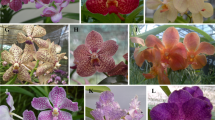Abstract
Taxifolin in larch is an important natural active ingredient, which prevents and treats liver diseases and cardiovascular diseases, and has many health benefits and application values such as anti-tumor, anti-virus, and anti-aging. However, the traditional extraction method is not conducive to the protection of the ecological environment, and also limits the industrial production of taxifolin from larch. Therefore, the purpose of this research is to establish a larch callus culture system and obtain taxifolin from callus. The shoots of the stem-tips of Larix olgensis were used as explants to be cultured. The light conditions, optimal medium and hormone ratio for callus induction were screened to evaluate the callus induction characteristics of larch and its influence on the accumulation of taxifolin. The results showed that: callus formation started on 28 ~ 51 days, and the best conditions for inducing callus were explored: 12 h/d light culture MS + 2,4-D 2 mg/L + 6-BA 1 mg/L + KT 0.1 mg/L; The callus induction rate was 50-80 %; The hormone combination with the highest accumulation of taxifolin was 6-BA 1 mg/L + NAA 0.1 mg/L, reaching 0.477 . In conclusion, this study revealed a suitable induction condition for larch callus culture and taxifolin accumulation.






Similar content being viewed by others
References
Ahmad TA, Al-Mahdawe MM, Nadir DS (2020) Effect of methyl jasmonate on the production of furanocoumarins in cell suspension cultures of Ruta graveolens L. Plant Cell Tissue Organ Cult. https://doi.org/10.1007/s11240-020-01941-z
Ahn JY, Choi SE, Jeong MS et al (2010) Effect of taxifolin glycoside on atopic dermatitis-like skin lesions in NC/Nga mice. Phyther Res. https://doi.org/10.1002/ptr.3084
Attree SM, Pomeroy MK, Fowke LC (1992) Manipulation of conditions for the culture of somatic embryos of white spruce for improved triacylglycerol biosynthesis and desiccation tolerance. Planta. https://doi.org/10.1007/BF00195664
Bonga JM, Pond SE (1991) Adventitious shoot formation in cultures of 30-year-old Larix decidua, L. leptolepis, L. eurolepis, and L. laricina trees. Plant Cell Tissue Organ Cult. https://doi.org/10.1007/BF00116609
Fu-heng L, Qing-hua X, ПOЛяKOB AB et al (2014) Screening of Optimal Differentiation Medium to Lonicera edulis. J Northeast Agric Univ . https://doi.org/10.1016/s1006-8104(15)30016-7 (English Ed.)
Fukui Y, Nakadome K, Ariyoshi H (1966) Studies on the monomer flavonoides of the plants of coniferae. II. Isolation of a new taxifolin glucoside from the leaves of Chamaecyparis obtusa Endlicher. Yakugaku Zasshi. https://doi.org/10.1248/yakushi1947.86.3_184
Ivanov I, Sidehmenova A, Smolyakova V et al (2014) Inhibition of adenosine diphosphate-induced platelet aggregation by alpha-lipoic acid and dihydroquercetin in vitro. Indian J Pharmacol. https://doi.org/10.4103/0253-7613.135958
Jao RC, Lai CC, Fang W, Chang SF (2005) Effects of red light on the growth of Zantedeschia plantlets in vitro and tuber formation using light-emitting diodes. HortScience.
Kim YJ, Choi SE, Lee MW, Lee CS (2008) Taxifolin glycoside inhibits dendritic cell responses stimulated by lipopolysaccharide and lipoteichoic acid. J Pharm Pharmacol. https://doi.org/10.1211/jpp/60.11.0007
LEWANDOWSKI A, BRUCZYK J, MEINARTOWICZ L (1991) Genetic structure and the mating system in an old stand of polish larch. Silvae Genet
Lu C, Vasil V, Vasil IK (1983) Improved efficiency of somatic embryogenesis and plant regeneration in tissue cultures of maize (Zea mays L.). Theor Appl Genet. https://doi.org/10.1007/BF00251161
Mehring A, Haffelder J, Chodorski J et al (2020) Establishment and triterpenoid production of Ocimum basilicum cambial meristematic cells. Plant Cell Tissue Organ Cult. https://doi.org/10.1007/s11240-020-01942-y
Moumou Y, Trotin F, Dubois J et al (1992) Influence of culture conditions on polyphenol production by fagopyrum esculentum tissue cultures. J Nat Prod. https://doi.org/10.1021/np50079a004
Murashige T, Skoog F (1962) A revised medium for rapid growth and bio assays with tobacco tissue cultures. Physiol Plant. https://doi.org/10.1111/j.1399-3054.1962.tb08052.x
Salajová T, Salaj J (2005) Somatic embryogenesis in Pinus nigra: Embryogenic tissue initiation, maturation and regeneration ability of established cell lines. Biol Plant. https://doi.org/10.1007/s10535-005-0003-z
Shiga T, Shoji K, Shimada H et al (2009) Effect of light quality on rosmarinic acid content and antioxidant activity of sweet basil, Ocimum basilicum L. Plant Biotechnol. https://doi.org/10.5511/plantbiotechnology.26.255
Stasolla C, Yeung EC (2003) Recent advances in conifer somatic embryogenesis: Improving somatic embryo quality. Plant Cell Tissue Organ Cult. 74:15–35
Teszlák P, Gaál K, Pour Nikfardjam MS (2005) Influence of grapevine flower treatment with gibberellic acid (GA 3) on polyphenol content of Vitis vinifera L. wine. Anal Chim Acta. https://doi.org/10.1016/j.aca.2005.04.013
Wang Y, Zu Y, Long J et al (2011) Enzymatic water extraction of taxifolin from wood sawdust of Larix gmelini (Rupr.) Rupr. and evaluation of its antioxidant activity. Food Chem. https://doi.org/10.1016/j.foodchem.2010.11.155
Zhao J, Zhu WH, Hu Q, He XW (2001) Enhanced indole alkaloid production in suspension compact callus clusters of Catharanthus roseus: Impacts of plant growth regulators and sucrose. Plant Growth Regul. https://doi.org/10.1023/A:1010732308175
Acknowledgements
The authors are thankful to professor Liu Wencong, College of traditional Chinese medicine, Jilin Agricultural University, and the straw biological utilization platform of the Ministry of education for their technical support.
Funding
This work were supported by the Changchun Science and Technology Bureau of Jilin Province (NO. 17YJ013).
Author information
Authors and Affiliations
Contributions
WL perceived and planned the experiment; XL, YZ and YZ transcribed the chief document text and investigated figures; CX and CD mainly performed statistics and figures drawing; WM, LD, QD and SX checked and modified the manuscript. All authors review and legalize the content of the manuscript.
Corresponding author
Ethics declarations
Conflict of interest
The authors declare that they have no conflict of interest.
Additional information
Communicated by Danny Geelen.
Publisher’s Note
Springer Nature remains neutral with regard to jurisdictional claims in published maps and institutional affiliations.
Xinglong Liu and Yingchun Zhao have contributed equally to this work.
Rights and permissions
About this article
Cite this article
Liu, X., Zhao, Y., Chen, X. et al. Establishment of callus induction system, histological evaluation and taxifolin production of Larch. Plant Cell Tiss Organ Cult 147, 467–475 (2021). https://doi.org/10.1007/s11240-021-02139-7
Received:
Accepted:
Published:
Issue Date:
DOI: https://doi.org/10.1007/s11240-021-02139-7




